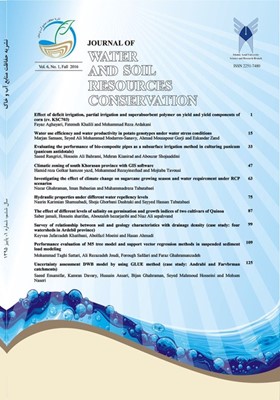-
-
List of Articles
-
Open Access Article
1 - Effect of Deficit Irrigation, Partial Irrigation and Superabsorbent Polymer on Yield and Yield Components of Corn (cv. KSC703)
Fayaz Aghayari Fatemeh Khalili Mohammad Reza Ardakani -
Open Access Article
2 - Water use efficiency and water productivity in potato genotypes under water stress conditions
Marjan Samaee Ali Mohammad Modares Sanavi Ahmad Mousapour Gorji Eskandar Zand -
Open Access Article
3 - Evaluating the Performance of Biocomposite Pipes as a Subsurface Irrigation Method in Culturing Panicum (Panicum antidotale)
saeed rangrizi hosseinali bahrami mehran kianirad aboozar shojaaddini -
Open Access Article
4 - Climatic Zoning of South Khorasan Province With GIS Software
hamid reza golkar hamzee yazd mohammad rezayinezhad mojtaba tavousi -
Open Access Article
5 - Investigation the effect of climate change on sugarcane growing season and water requirement under RCP scenarios
Nozar Ghahraman Iman Babaeian Muhammadreza Tabatabaei -
Open Access Article
6 - Hydraulic properties under different water repellency levels
Nasrin Karimian Shoja Ghorbani Hassan Tabatabaei -
Open Access Article
7 - The effect of different levels of salinity on germination and growth indices of two cultivars of Quinoa
Saber jamali Hossein sharifan Aboutaleb hezarjaribi Niaz Ali sepahvand -
Open Access Article
8 - Survey of relationship between soil and geology characteristics with drainage density (Case study: four watersheds in Ardebil province)
keivan jafarzadeh khatibani Abolfazl moeini Hasan Ahmadi -
Open Access Article
9 - Performance Evaluation of M5 Tree Model and Support Vector Regression Methods in Suspended Sediment Load Modeling
Mohammad Taghi Sattari علی رضازاده جودی Forugh Safdari فراز قهرمانیان -
Open Access Article
10 - Uncertainty assessment DWB model by using GLUE method (Case study: Andrabi and Farvbrman catchments)
Saeed Emamifar Kamran Davari Hussain Ansari Bijan Ghahraman Seyed Mahmoud Hosseini Mohsen Nasseri
-
The rights to this website are owned by the Raimag Press Management System.
Copyright © 2021-2025







